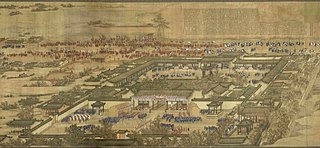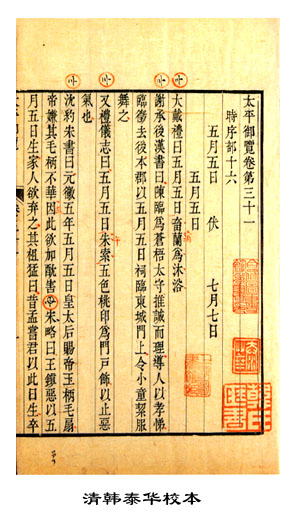
Yixin, better known in English as Prince Kung or Gong, was an imperial prince of the Aisin Gioro clan and an important statesman of the Manchu-led Qing dynasty in China. He was a regent of the empire from 1861 to 1865 and wielded great influence at other times as well.

A yamen was the administrative office or residence of a local bureaucrat or mandarin in imperial China, Korea, and Vietnam. A yamen can also be any governmental office or body headed by a mandarin, at any level of government: the offices of one of the Six Ministries is a yamen, but so is a prefectural magistracy. The term has been widely used in China for centuries, but appeared in English during the Qing dynasty.

The Hanlin Academy was an academic and administrative institution of higher learning founded in the 8th century Tang China by Emperor Xuanzong in Chang'an. It has also been translated as "College of Literature" and "Academy of the Forest of Pencils."

Amban is a Manchu language term meaning "high official", corresponding to a number of different official titles in the imperial government of Qing China. For instance, members of the Grand Council were called Coohai nashūn-i amban in the Manchu language and Qing governor-generals were called Uheri kadalara amban.

Yikuang, formally known as Prince Qing, was a Manchu noble and politician of the Qing dynasty. He served as the first Prime Minister of the Imperial Cabinet, an office created in May 1911 to replace the Grand Council.

The Zongli Yamen, short for Office for the General Management of Affairs Concerning the Various Countries (總理各國事務衙門), also known as Prime Minister's Office, Office of General Management, was the government body in charge of foreign policy in imperial China during the late Qing dynasty. It was established by Prince Gong on 11 March 1861 after the Convention of Beijing. It was abolished by the Qing government in 1901 and replaced with a Foreign Office of ministry rank.

The Siku Quanshu, literally the Complete Library of the Four Treasuries, was a Chinese encyclopedia commissioned by the Qing dynasty's Qianlong Emperor in 1772, and completed in 1782. It is the largest collection of books in imperial Chinese history, comprising 36,381 volumes, 79,337 manuscript rolls, 2.3 million pages, and about 997 million words. The complete encyclopedia contains an annotated catalogue of 10,680 titles along with a compendiums of 3,593 titles. The Siku Quanshu surpassed the 1403 Yongle Encyclopedia created by the previous Ming dynasty, which had been China's largest encyclopedia. Complete copies of the Siku Quanshu are held at the National Library of China in Beijing, the National Palace Museum in Taipei, the Gansu Library in Lanzhou, and the Zhejiang Library in Hangzhou.

The National Library of China (NLC) is the national library of China, located in Haidian, Beijing, and is one of the largest libraries in the world. It contains over 41 million items as of December 2020. It holds the largest collection of Chinese literature and historical documents in the world and covers an area of 280,000 square meters. The National Library is a public welfare institution funded by the Ministry of Culture and Tourism.
The Lifan Yuan was an agency in the government of the Qing dynasty of China which administered the empire's Inner Asian territories such as Mongolia and oversaw the appointments of Ambans in Tibet. Until the 1860s, it was also responsible for the Qing's relations with the Russian Empire.

Sir Robert Hart, 1st Baronet, was a British diplomat and official in the Qing Chinese government, serving as the second Inspector-General of China's Imperial Maritime Custom Service (IMCS) from 1863 to 1911. Beginning as a student interpreter in the consular service, he arrived in China at the age of 19 and resided there for 54 years, except for two short leaves in 1866 and 1874.

Li Shanlan was a Chinese mathematician of the Qing Dynasty.

Manual of the Mustard Seed Garden, sometimes known as Jieziyuan Huapu (芥子園畫譜), is a printed manual of Chinese painting compiled during the early-Qing Dynasty. Many renowned later Chinese painters, like Qi Baishi, began their drawing lessons with the manual. It is an important early example of colour printing.

Chinese encyclopedias comprise both Chinese language encyclopedias and foreign language ones about China or Chinese topics. There is a type of native Chinese reference work called leishu that is sometimes translated as "encyclopedia", but although these collections of quotations from classic texts are expansively "encyclopedic", a leishu is more accurately described as a "compendium" or "anthology". The long history of Chinese encyclopedias began with the Huanglanleishu and continues with online encyclopedias such as the Baike Encyclopedia.

"Four Barbarians" was a term used by subjects of the Zhou and Han dynasties to refer to the four major people groups living outside the borders of Huaxia. Each was named for a cardinal direction: the Dongyi, Nanman, Xirong, and Beidi. Ultimately, the four barbarian groups either emigrated away from the Chinese heartland or were partly assimilated through sinicization into Chinese culture during later dynasties. After this early period, "barbarians" to the north and the west would often be designated as "Hu" (胡).

The Treaty of Livadia was an unequal treaty between the Russian Empire and the Chinese Qing dynasty signed in Livadiya, Crimea, on 2 October 1879, wherein Russia agreed to return a portion of the lands it had occupied in Xinjiang during the Dungan Revolt of 1862–1877. Even though Qing forces had reconquered the area, the resulting treaty was extremely unfavorable to China. As a result, the Qing government refused to ratify it and the emissary who made the negotiations was sentenced to death. Seventeen months later, the two nations signed the Treaty of Saint Petersburg, which apart from territorial matters, largely had the same terms as the Treaty of Livadia.

The Zhuangpiao, alternatively known as Yinqianpiao, Huipiao, Pingtie (憑帖), Duitie (兌帖), Shangtie (上帖), Hupingtie (壺瓶帖), or Qitie (期帖) in different contexts, refer to privately produced paper money made in China during the Qing dynasty and early Republic of China periods issued by small private banks known as qianzhuang. Other than banknotes qianzhuang also issued Tiexian.

Shilin Guangji is an encyclopedia written by Chen Yuanjing during the Yuan dynasty. The book contains text written in Chinese characters, Mongolian script, and the ʼPhags-pa script. Chen Yuanjing was a native of Chong'an (崇安) in Fujian and was born during the later years of the Southern Song dynasty. The encyclopedia contains a wealth of info on the daily life during the Mongol Empire and Yuan dynasty, including illustrations, maps and cartography. Among historical texts, it was easy to understand and popular even after the Yuan dynasty. Chen's book was used by scholars during the Ming and Qing dynasties to compile their own encyclopedias.
China and the West, 1858–1861: The Origins of the Tsungli Yamen is a 1964 nonfiction English language book by Masataka Banno, published by Harvard University Press. It describes the start of the Zongli Yamen and the political developments that resulted in the establishment of the "unequal treaties."
While the Qing dynasty of China tried to maintain the traditional tributary system of China, by the 19th century Qing China had become part of a European-style community of sovereign states and had established official diplomatic relations with over twenty countries around the world before its downfall in 1912. It also established legations and consulates known as the "Chinese Legation", "Imperial Consulate of China", "Imperial Chinese Consulate (General)" or similar names in seventeen countries since the 1870s.
















